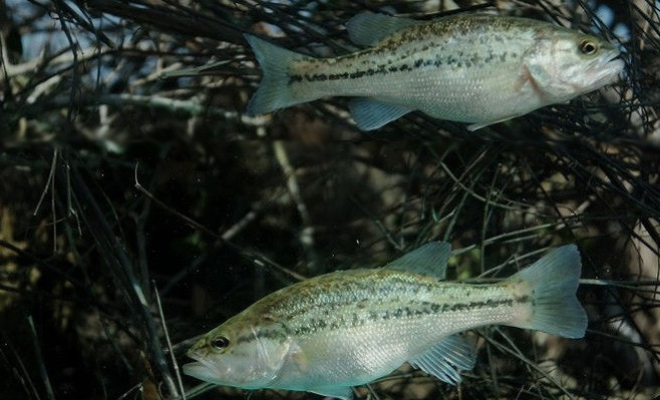Pond vegetation provides oxygen, clarity, food sources, spawning grounds, and hiding places for fish. So, the more you have the better, right? Think again! Like always, too much of a good thing can be a bad thing…but with the multitude of vegetation control options available, you can relax knowing your fish are happy and healthy.
Vegetation overgrowth can cause many issues in a pond ecosystem besides just being unsightly. When there is an excessive amount, it can even lead to a detrimental fish kill! Hot temperatures combined with a high volume of vegetation and overcast weather deplete the dissolved oxygen in a pond or lake, as well as swing the pH levels to an unhealthy range.
When this pH-oxygen cycle is in balance, all is well. However when it gets out of balance, your fish may be in trouble! With preventative measures, your pond will stand a much better chance of taking these natural swings with grace and your fish will remain protected. Managing vegetation (especially in summertime) is the most controllable parameter for pond owners, and once you know some background, it is easily done.
Pond plants are ranked in the following four categories: Algae/Plankton, Floating Plants, Submerged Plants, and Emergent Plants. Each of these categories has different management requirements, so it is important to know what kind of vegetation you are dealing with in your pond or lake. Resources such as www.aquaplant.tamu.edu and your local Parks and Wildlife Department are great starting points for identifying vegetation.
Once identified, pond owners have the option between biological control, chemical control, physical control, and geographical control to battle the ever-growing vegetation. Let’s get into a break-down of each:
Biological control, which is the most recommended method, is the act of stocking fish species that consume large amounts of vegetation. Grass Carp and Tilapia are the most popular species, and both do a great job at keeping plants at bay. Grass Carp are sold in the State of Texas only as Triploid fish, meaning that they are completely sterile. They are so good at their job, in fact, that they must not be able to reproduce, and they require a permit for purchase. Since they are strictly vegetarian and extremely hardy, they could be very detrimental to an ecosystem that does not need their services. Permits for Grass Carp are easily acquired through the Texas Parks and Wildlife online portal. Tilapia on the other hand, only require a permit based on pond location. If your pond falls in the “Conservation Zone”, a permit is indeed required. Tilapia are a great short-term option for vegetation control, as they work efficiently in a short period of time, but they are an African species that do not do well in cold water temperatures. Typically, tilapia start to die at about 57 degrees F. Many pond owners opt to stock them in the early spring when water temperatures rise, and then stock annually for vegetation control.
Chemical control is also very effective, but mistakes in dosage are easily made. Products such as Cutrine, Polaris, Diquat, and more are frequently used to control vegetation. Though expensive, they are arguably the easiest route to take when fighting off aquatic plants. It is crucial to apply these chemicals correctly, because if an overdose occurs, a fish kill can happen easily. A somewhat safer chemical option is pond dye, which controls vegetation by blocking sunlight to deeper portions of water, halting photosynthesis. Dosage is important in its usage as well, though, because dyeing a pond too dark too fast will block the majority of photosynthesis causing an extreme depletion in dissolved oxygen.
Physical control includes physically taking the vegetation out of the pond by hand, tool, or machine. Though labor intensive, this option yields the fastest results. Rakes, shovels, tractor buckets, and grapples are most commonly used for this method. It is a very temporary fix, however, and does not exactly get to the “root” of the problem (pun intended).
Geographical control entails the modification of the pond itself or the area around it to prevent plant growth. Draining the pond to dry out floating vegetation and algae, adding rocks and structure to prevent submerged plants from rooting, or constructing a pond with a liner to block out a multitude of plants are all methods of this control option. Typically, geographical controls are done before the pond is dug, so it is ruled out by many pond owners if they already have existing ponds.
As you can see, there are many paths to choose from! Depending on your specific situation, some options are better than others. Here at Henneke Hatchery, we can help you choose which route is the right one for you! Give us a call today at 361-798-5934 to inquire.
Author: Jordan Moore
